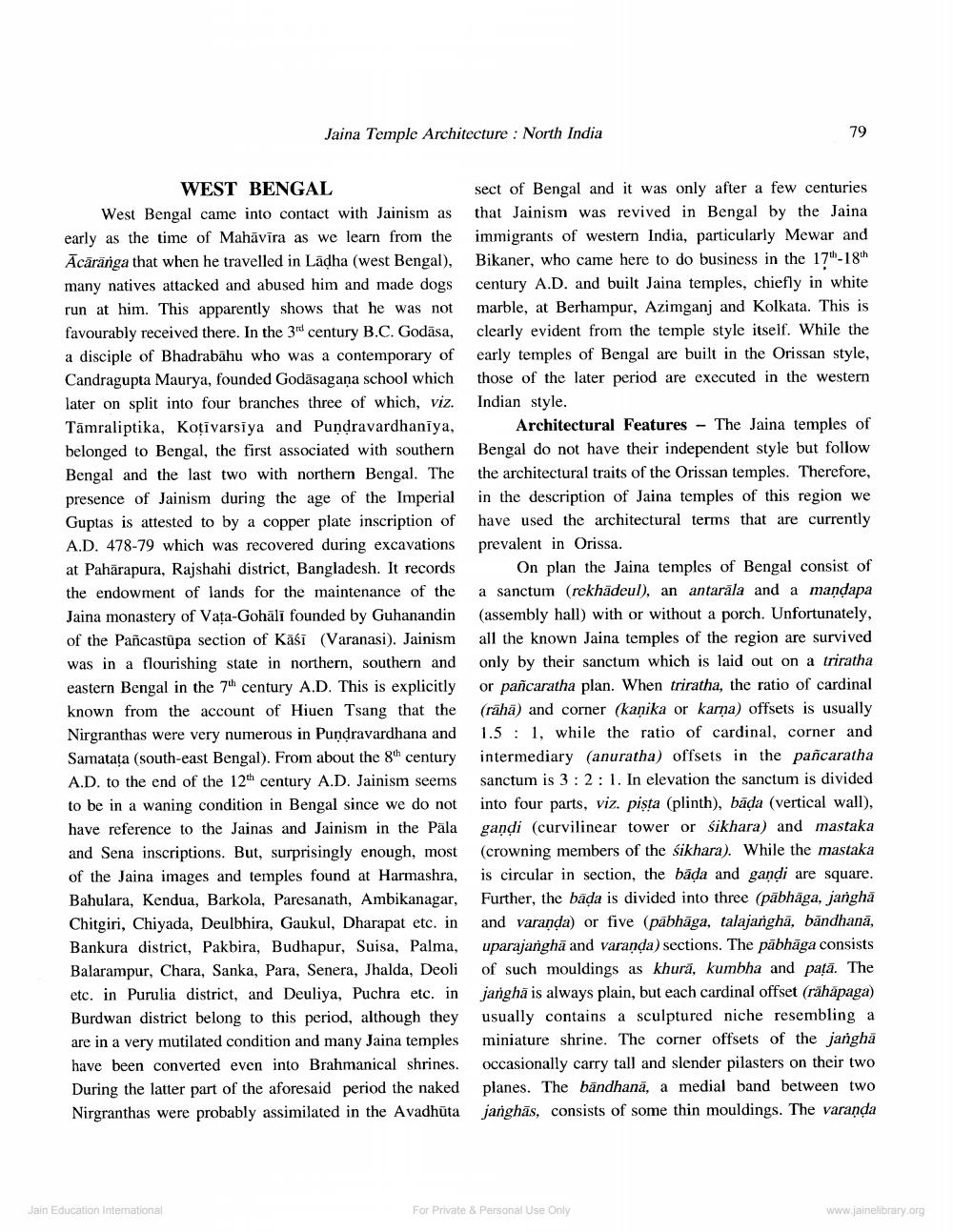________________
Jaina Temple Architecture : North India
79
WEST BENGAL West Bengal came into contact with Jainism as early as the time of Mahāvīra as we learn from the Acārānga that when he travelled in Ladha (West Bengal), many natives attacked and abused him and made dogs run at him. This apparently shows that he was not favourably received there. In the 3rd century B.C. Godāsa, a disciple of Bhadrabāhu who was a contemporary of Candragupta Maurya, founded Godāsagana school which later on split into four branches three of which, viz. Tāmraliptika, Koțivarsiya and Pundravardhaniya, belonged to Bengal, the first associated with southern Bengal and the last two with northern Bengal. The presence of Jainism during the age of the Imperial Guptas is attested to by a copper plate inscription of A.D. 478-79 which was recovered during excavations at Pahärapura, Rajshahi district, Bangladesh. It records the endowment of lands for the maintenance of the Jaina monastery of Vata-Gohāli founded by Guhanandin of the Pancastūpa section of Kasi (Varanasi). Jainism was in a flourishing state in northern, southern and eastern Bengal in the 7h century A.D. This is explicitly known from the account of Hiuen Tsang that the Nirgranthas were very numerous in Pundravardhana and Samatata (south-east Bengal). From about the 8th century A.D. to the end of the 12th century A.D. Jainism seems to be in a waning condition in Bengal since we do not have reference to the Jainas and Jainism in the Pala and Sena inscriptions. But, surprisingly enough, most of the Jaina images and temples found at Harmashra, Bahulara, Kendua, Barkola, Paresanath, Ambikanagar, Chitgiri, Chiyada, Deulbhira, Gaukul, Dharapat etc. in Bankura district, Pakbira, Budhapur, Suisa, Palma, Balarampur, Chara, Sanka, Para, Senera, Jhalda, Deoli etc. in Purulia district, and Deuliya, Puchra etc. in Burdwan district belong to this period, although they are in a very mutilated condition and many Jaina temples have been converted even into Brahmanical shrines. During the latter part of the aforesaid period the naked Nirgranthas were probably assimilated in the Avadhūta
sect of Bengal and it was only after a few centuries that Jainism was revived in Bengal by the Jaina immigrants of western India, particularly Mewar and Bikaner, who came here to do business in the 17h-18th century A.D. and built Jaina temples, chiefly in white marble, at Berhampur, Azimganj and Kolkata. This is clearly evident from the temple style itself. While the early temples of Bengal are built in the Orissan style, those of the later period are executed in the western Indian style.
Architectural Features - The Jaina temples of Bengal do not have their independent style but follow the architectural traits of the Orissan temples. Therefore, in the description of Jaina temples of this region we have used the architectural terms that are currently prevalent in Orissa.
On plan the Jaina temples of Bengal consist of a sanctum (rekhädeul), an antarala and a mandapa (assembly hall) with or without a porch. Unfortunately, all the known Jaina temples of the region are survived only by their sanctum which is laid out on a triratha or pañcaratha plan. When triratha, the ratio of cardinal (rāhā) and corner (kanika or karna) offsets is usually 1.5 : 1, while the ratio of cardinal, corner and intermediary (anuratha) offsets in the pañcaratha sanctum is 3: 2:1. In elevation the sanctum is divided into four parts, viz. pista (plinth), bāda (vertical wall), gandi (curvilinear tower or sikhara) and mastaka (crowning members of the sikhara). While the mastaka is circular in section, the bāda and gandi are square. Further, the bāda is divided into three (pābhäga, jangha and varanda) or five (pābhāga, talajanghā, bāndhanā, uparajanghā and varanda) sections. The pābhāga consists of such mouldings as khura, kumbha and patā. The janghā is always plain, but each cardinal offset (rähāpaga) usually contains a sculptured niche resembling a miniature shrine. The corner offsets of the jangha occasionally carry tall and slender pilasters on their two planes. The bandhanä, a medial band between two janghās, consists of some thin mouldings. The varanda
Jain Education Intemational
For Private & Personal Use Only
For Private & Personal Use Only
www.jainelibrary.org




